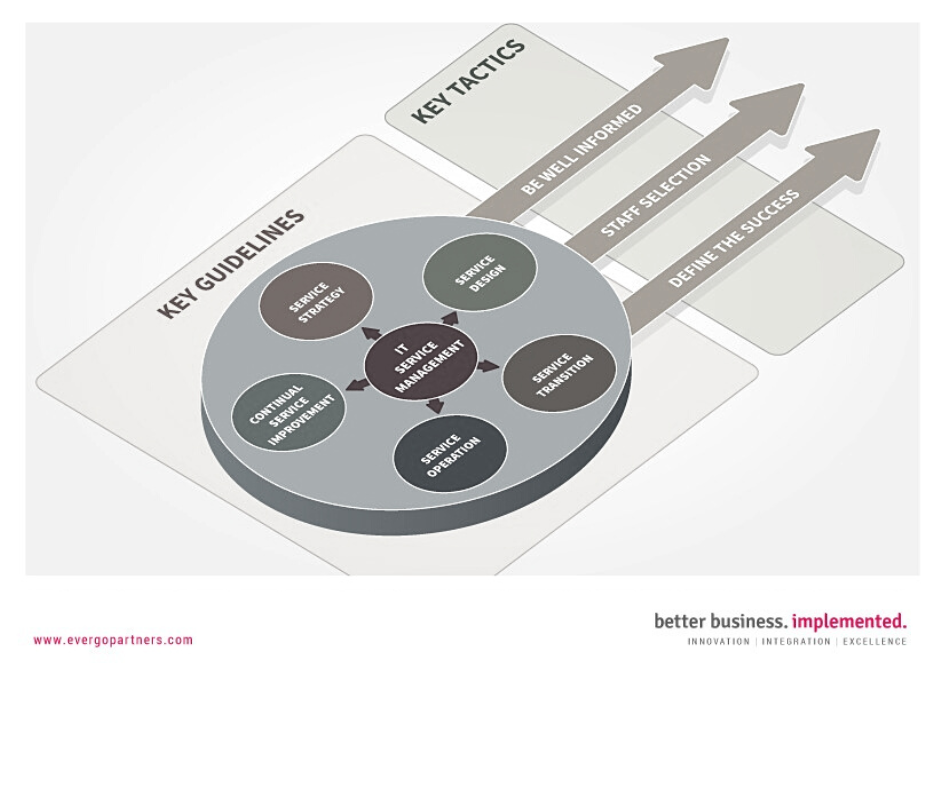Introduction
Implementing ITSM platform successfully should lead to clear understanding of all processes among all stakeholders. There are many benefits of success but the question is: how do you get there? How to deliver value to each customer group?
Focus on high level goals
Focusing on the high-level goals of your implementation will keep you on the right track to make a big difference in the organization. There might be processes within your organization that require lengthy analysis to get it right. Make sure you always spend your time on the ITIL implementation project where the priority is the highest and agreed upon. At the same time if the high level goals are not identified it is crucial to have honest discussion with the key stakeholders on why ITSM platform is required. Clear goals will enable the implementation team to focus on processes where it is most needed.
It is good practice to sub-divided your goals into short, medium and long term goals. This approach allows to structure the approach according to the demands of the business. Goals must be reviewed regularly to ensure up-to-date focus of the project. This categorization of goals and review will enable companies to become more agile at meeting the customer expectations.
ITIL is a set of guidelines
Remember that ITIL is a set of guidelines and it should be used as such. You are welcome to make your own interpretation and apply it how you see it best fit for your organization. Every company has different ways of working and that must be acknowledged in your implementation. During the implementation consider if specific guideline is applicable for your company culture or if it needs to be modified or skipped. Often companies feel that if they are not able to implement all ITIL guidelines their implementation was unsuccessful. That’s false. Below are key guidelines to remember in your implementation project. All are described in detail in the five ITIL practitioner books in detail.
Service Strategy
Identifying Service Strategy paints the picture of how we, as an IT organization, want to support the business. Service Strategy describes what must be done to design, deliver, manage, support IT services.
Service Design
Service Design allows to understand what skill sets are needed, what hardware and software is required to achieve what has been identified in Service Strategy. Service Design focuses on consistency and continuity of IT services.
Service Transition
Service Transition provides guidance on changes going to production. It focuses on knowledge management.
Service Operation
Service Operation is where it all happens. The service desk, support, etc. all functions which support the IT operations.
Continual Service Improvement
Continual Service Improvement enables all stakeholders monitor operations and act. This part of the framework focuses on quality control by setting up measurements such as KPIs, SLAs and verifying them to ensure everything is delivered as expected.
3 key tactics for successful implementation
Finding the right balance between all the project constrains is always the biggest hurdle especially in an ITSM implementation. Below good practices will help you to achieve success.
Be well informed
Knowing your strengths and weaknesses sets the stage and enables you to move smoothly through the project. Be sure you have all the ITIL framework knowledge that is necessary. If you don’t have it acquire it through training or review of literature. Proper understanding of the frameworks will enable to make educated choices among what to implement now vs. later.
Staff selection
As part of one of the first steps you must verify if you are able to do implementation in house or if you need external help. Sometimes it the knowledge is all in house or requires only minor upgrade. Good practice is to be open and make staff decisions in a large cooperation with all, and we stress all, stakeholders.
Define the success
If a project team does not have a clear understanding of what is the success criteria the success will not happen. As early as possible it is at most important to define what the success will mean for the project. When you define success, you will be able to measure and control success of your implementation project. ITIL framework provides resources on establishing key indicators of success. You must pick wisely to ensure you do not overburden your organization.

Monitoring
Successful implementation is not the end. It is the beginning. It is transformation to the new culture and it must be monitored. Monitoring should happen as frequent as necessary for each function. As part of the monitoring the Continual Improvement Process (CIP) kicks in to learn and adjust. CIP enables to extend the project into the future to identify weaknesses and benefit from the organization strengths.




